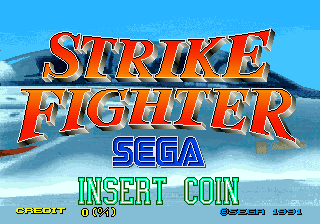Difference between revisions of "Strike Fighter"
From Sega Retro
m (Text replace - "Category:Y Board Games" to "Category:Y Board games") |
|||
| Line 22: | Line 22: | ||
==Physcial Scans== | ==Physcial Scans== | ||
| − | + | {{Scanflyer | |
| + | | console=Y Board | ||
| + | | region=JP | ||
| + | | page1=StrikeFighter YBoard JP Flyer.jpg | ||
| + | }} | ||
{{Clear}} | {{Clear}} | ||
Revision as of 14:51, 7 June 2013
| Strike Fighter | |||||
|---|---|---|---|---|---|
| System(s): Sega Y Board | |||||
| Publisher: Sega | |||||
| Developer: Sega AM2 | |||||
| Genre: Shoot-'em-Up | |||||
| Number of players: 1 | |||||
|
This short article is in need of work. You can help Sega Retro by adding to it.
Strike Fighter is an arcade game released for Sega Y Board hardware in 1991. It is a sequel to G-LOC: Air Battle, which itself is now seen as a spin-off of the After Burner franchise.
Strike Fighter, like G-LOC primarily takes place from a cockpit view, where the player is tasked with shooting down enemy planes (while making sure not to be shot down themselves). Also like G-LOC, the game pans out to a third-person perspective if an enemy is on your tail. The major difference between the two is that whereas G-LOC uses a goal-based mission system, Strike Fighter's levels are similar in design to After Burner's, simply finishing when the player reaches a certain distance.
Strike Fighter saw most of its content re-branded as After Burner III for the Sega Mega CD. The main difference between the two from a gameplay perspective is that After Burner III always gives users the option of playing from a third-person perspective. Strike Fighter on its own has not been ported to any home consoles.
